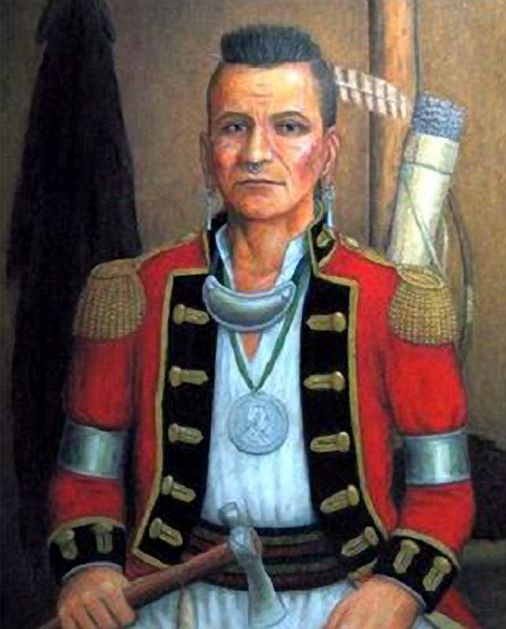Blue Jacket or Weyapiersenwah (c. 1743 – c. 1810) was a war chief of the Shawnee people, known for his militant defense of Shawnee lands in the Ohio Country.
Perhaps the preeminent American Indian leader in the Northwest Indian War, in which a pan-tribal confederacy fought several battles with the United States, he was an important predecessor of the famous Shawnee leader Tecumseh.

Blue Jacket, Shawnee Chief. Painting by Hal Sherman based on Blue Jacket description.
Weyapiersenwah “Blue Jacket” Shawnee War Chief |
|
| Birthdate: | (74) |
| Birthplace: | Pennsylvania, United States |
| Death: | circa 1809 (66-82) Wyandotte, Wayne County, Michigan, United States |
| Place of Burial: | Wyandotte, Wayne County, Michigan, United States |
|---|---|
| Immediate Family: |
Son of Lawaquaqua Pride Opessa and Sarah “Techacha” Morning Star Rising Sun |
The Shawnee Bluejacket family reaches back into the mid-1700s. This family arose from the French and Indian War period, proliferated during the American Revolution, Fought the Americans who usurped their homelands, became involved in the War of 1812, suffered through Indian Removal, became successful Kansan farmers, were run out for their efforts, then settled for good in Indian Territory.
Now they reside in the Cherokee Nation, Eastern Shawnee Tribe and the Shawnee Tribe.
Records begin with Chief Bluejacket himself, also known by his Native names of Se-pet-te-he-nath, Big Rabbit, his name given at birth and Wa Weyapiersehnwaw, his adult chosen name, found in use about 1777.
Blue Jacket, one of Cornstalk’s warrior’s, lived as Se-pet-te-ke-na-the, Big Rabbit, until as late as 1776.
The demise of Cornstalk elevated Blue Jacket in the hierarchy of Indian-American warfare and he likely selected his later name of Waweypiersenwaw, the Whirlpool, as one more fitting to his newly gained responsibilities. A recorded but obscure name for him, was Sasesequa. British traders called him Blue Jacket in their records of transactions, beginning as early as 1752.
Little is known of Blue Jacket’s early life. He first appears in written historical records in 1773, when he was already a grown man and a war chief. In that year, a British missionary visited the Shawnee villages on the Scioto River and recorded the location of Blue Jacket’s Town on Deer Creek (present Ross County, Ohio).
This would put BlueJacket’s birth at least before 1750. Historians estimate it to be about 1743.
Blue Jacket participated in Dunmore’s War and the American Revolutionary War (allied with the British), always attempting to maintain Shawnee land rights. With the British defeat in the American Revolutionary War, the Shawnee lost valuable assistance in defending the Ohio Country. The struggle continued as white settlement in Ohio escalated, and Blue Jacket was a prominent leader of the resistance.
On November 3, 1791, the army of a confederation of Indian tribes, led by Blue Jacket and Miami Chief Little Turtle, defeated an American expedition led by Arthur St. Clair, governor of the Northwest Territory. The engagement, known as the Battle of the Wabash or as St. Clair’s Defeat, was the crowning achievement of Blue Jacket’s military career, and the most severe defeat ever inflicted upon the United States by Native Americans.
Blue Jacket’s triumph was short-lived. The Americans were alarmed by St. Clair’s disaster and raised a new professional army, commanded by General Anthony Wayne. On August 20, 1794, Blue Jacket’s confederate army clashed with Wayne at the Battle of Fallen Timbers, just south of present-day Toledo, Ohio. Blue Jacket’s army was defeated, and he was compelled to sign the Treaty of Greenville on August 3, 1795, ceding much of present-day Ohio to the United States.
In 1805, Blue Jacket also signed the Treaty of Fort Industry, relinquishing even more of Ohio. In Blue Jacket’s final years, he saw the rise to prominence of Tecumseh, who would take up the banner and make the final attempts to reclaim Shawnee lands in the Ohio Country.
Later a story spread that he was in fact a European settler named Marmaduke Van Swearingen, who had been captured and adopted by Shawnees in the 1770s, around the time of the American Revolutionary War. This story, popularized in historical novels written by Allan W. Eckert in the late 1960s, remains well known in Ohio, where an outdoor drama celebrating the life of the white Indian chief was performed yearly in Xenia, Ohio from 1981 until 2007.
However, subsequent DNA testing proved that story to be false. Bluejacket’s DNA is unquestionably Native, and the Swearingen family’s is not. Not only does the Bluejacket and Swearingen DNA not match, they are not even in the same haplogroup. Swearingen is European, so they haven’t shared a common ancestors in 10s of thousands of years.
Further Reading:
Native American DNA of the Shawnee Bluejacket family
Daugherty / Dougherty Native American DNA
Lineage of Blue Jacket (193 pages)

